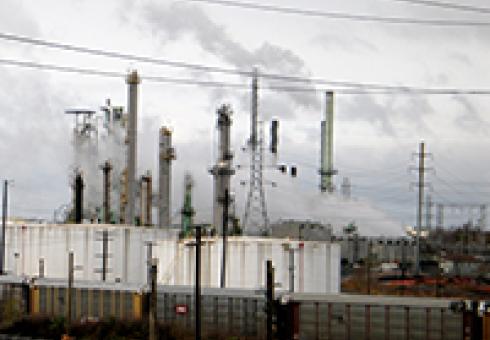At Climate Week conference, MIT Joint Program lays out the 2C challenge for oil and gas producers
News and Outreach: John Reilly
Climate deniers often cite uncertainty in climate models and other scientific evidence. Researchers challenge this argument in a new essay published in Science, suggesting climate scientists should place more emphasis on the risks of inaction. Joint Program Co-Director John Reilly comments.
Cheap oil fuels other parts of the world economy
John Reilly | MarketWatch
The crash in the price of oil — from $108 a barrel in June 2014 to below $27 earlier this year — has rattled the stock market, triggered layoffs across the energy sector, and plunged many oil producing countries into crisis.
Oil has since rebounded significantly from its lows, to above $40 a barrel, but the price plunge since 2014 has put much pressure on oil companies. Reports have pointed to an increase in debt among oil producers, raising the specter of default on bankruptcy and default on debt, with follow-on effects beyond oil producers.
The upheaval also has sparked fears that oil’s troubles will spread across the globe, echoing the crash in U.S. housing markets that pushed the world economy to the brink of collapse in 2008. Yet despite the woes oil is experiencing, it is unlikely that the repercussions will trigger another global financial crisis.
Looking at the numbers, the mortgage-debt crisis dwarfs what is currently happening in oil. According to a report in the Financial Times, the global oil and gas industry’s debts rose to $3 trillion from $1.1 trillion between 2006 and 2014. Compare that to the $10 trillion of housing debt weighing on Americans in 2008.
Aside from the numbers, the impact will be different because of the nature of the oil industry and the role oil plays in the world economy. Boom and bust have been features of the oil business for many years. Companies that have been around for a while understand this, and have learned to adapt. Responding to earlier crises, they made significant cuts and improved efficiency. Because they run lean operations, these companies are better prepared to weather downturns. Also, the major players in the oil industry are not highly leveraged, and thus we have not seen anything like the cascade of failures among lenders and suppliers that made the housing bust so damaging.
It is also important to note that the marginal cost of extracting oil from the ground is relatively low once the initial cost of developing a field is sunk. Even if prices are low, companies can continue to make money. It won’t be as much as they would make in good times, but the businesses can still generate revenue and profits. When oil companies cut back, they halt or delay investments in new fields, but their existing wells continue to produce.
Although some smaller or newer oil companies have been forced out of business by the price collapse, the larger, established players are unlikely candidates for bankruptcy. What tends to happen in the oil business is consolidation, which has been a feature of the industry for nearly two decades: look at Exxon XOM, +0.71% and Mobil; Chevron CVX, +0.39% and Texaco; BP BP, -1.46% and Amoco, and other mergers that occurred in the 1990s and early 2000s — another time when oil prices were extremely low.
That round of mergers and acquisitions reduced the number of companies considerably, and so room for further consolidation may be limited. Also, many of the remaining companies are state-owned or state-controlled and thus not candidates for acquisition or merger unless governments that owned them decided to privatize the assets — an unlikely scenario. But smaller operators with potentially valuable mineral rights will become candidates for acquisition by cash-rich larger companies.
When weighing the fallout from the oil price collapse, it is important to remember that whatever direction oil prices move, there will be winners and losers. While today the oil industry struggles, other industries, including transportation and manufacturing, are enjoying the benefits of low-cost oil. The fortunes of regions also rise and fall with the price of oil. When the price is high, Texas booms and New England struggles. Falling prices bring the reverse.
Perhaps the most serious consequence of today’s cheap oil is the damage done to governments that rely heavily on tax revenue from oil production. Many of the big oil-producing countries depend heavily on oil revenue to deliver basic services. With the collapse in prices, governments have to cut support for everything from medical care to housing to road repair. Tight budgets, in turn, can fuel political unrest, which may destabilize governments.
The damage to governments is easy to see in Venezuela, Nigeria, and Russia. But it also is apparent in wealthy countries such as Saudi Arabia, which has had to trim its domestic budget and pull back on investment outside of the country. Foreign nationals who traditionally have made up a large part of the Saudi work force may find less opportunity there, which creates a spillover effect in their home countries.
But for most of the world, assessing the effects of the oil price collapse is a process of calculating the many pluses and minuses. Oil industry workers may have much lighter paychecks these days, but consumers have a bit more in their wallets after filling the gas tank.
John Reilly is a senior lecturer at the MIT Sloan School of Management and co-director of the MIT Joint Program on the Science and Policy of Global Change, Center for Energy and Environmental Policy Research.
Photo: Detroit oil refinery (Photo courtesy of Grangernite)
Study finds high risk of severe water stress in Asia by 2050
Joint Program Co-Director John Reilly featured in CLP New Horizons
The following article appeared in CLP New Horizons, a compendium of news and perspectives on how to move the Asia-Pacific region toward a more sustainable energy future:
John Reilly | MIT Joint Program on the Science and Policy of Global Change
We live in a world where water, energy, land and the environment are inextricably linked. For example, water is used to produce electricity from hydropower as well as for thermal cooling. Water withdrawals for agriculture—the world’s largest consumer of water—deplete rivers and streams, thereby impacting freshwater ecosystems. Such ecosystems are also threatened by the discharge of water from power stations, which increases water temperature, and by the collection of water in large dams.
Dams not only produce hydropower but also store water from spring snowmelt or rainy seasons for use in irrigation during dry spells, and provide recreational opportunities as well. Use of water for hydropower, irrigation and recreation requires a careful balance. The availability of water for irrigation will partly determine land use, and how land is managed can affect runoff and sedimentation in reservoirs and other bodies of water, potentially degrading water quality and ecosystems.
Other energy, industry and domestic uses of water can be substantial in areas where water resources are limited. For example, there’s concern that development of China’s shale gas resources, located in dryer western regions of China, could be constrained by water availability.
Global changes
In Asia, population growth and economic development are increasing demand for water, food and energy, exacerbating conflicts among land, water and energy needs. In addition, climate change is expected to significantly affect agricultural productivity worldwide and alter the supply of water. While global warming will, in general, speed the hydrological cycle and lead to more precipitation, rainfall will be unevenly spread across the globe, and many currently water-stressed areas will become more stressed.
Efforts to reduce greenhouse gas emissions will change the energy mix, and if renewable sources like wind and solar become more widely used, smaller water withdrawals will be needed for thermal cooling. On the other hand, if biomass energy is part of the mitigation solution, that could increase pressure on land and indirectly on water in order to increase food crop yields.
Rising concerns for fresh water ecosystems may lead to restrictions on the amount of water withdrawn from rivers and lakes. Many areas are already considered overused. In addition, areas relying on groundwater resources may become unsustainable.
Building a more sustainable future
Businesses can take a number of steps to build a more sustainable future. First, by reducing greenhouse gas (GHG) emissions—ideally supported by government incentives—they can limit the amount of climate change in the coming decades. Second, they can adopt practices that improve water use efficiency and maintain water quality. Third, they can take climate change into consideration when planning the location of new facilities, while noting the uncertainties in climate models.
Our recent research indicates that water stress will increase in China and India. In China, climate change and growth are expected to exacerbate water stress; in India, climate change is projected to have a neutral effect on water supplies, although growth will likely increase water stress. In mainland Southeast Asia, climate change is expected to increase water supplies, partly offsetting the impact of growth.
In all regions, the range of possibilities are far wider than the historical variability in water resources. This highlights the difficulty involved in facilities planning.
References
Modeling U.S. water resources under climate change Blanc, É., K. Strzepek, A. Schlosser, H. Jacoby, A. Gueneau, C. Fant, S. Rausch and J. Reilly, Earth's Future, 2(4): 197–224 (doi:10.1002/2013EF000214), 2014
Climate change impacts and greenhouse gas mitigation effects on U.S. water quality Boehlert, B., K.M. Strzepek, S.C. Chapra, C. Fant, Y. Gebretsadik, M. Lickley, R. Swanson, A. McCluskey, J.E. Neumann and J. Martinich, Journal of Advances in Modeling Earth Systems, 7(3): 1326–1338, 2015
Impacts on Resources and Climate of Projected Economic and Population Growth Patterns Reilly, J. , The Bridge (National Academy of Engineering), 45(2): 6–15, 2015
The future of global water stress: An integrated assessment Schlosser, C.A., K. Strzepek, X. Gao, C. Fant, É. Blanc, S. Paltsev, H. Jacoby, J. Reilly and A. Gueneau, Earth's Future, 2(8): 341-361 (doi:10.1002/2014EF000238), 2014
A Framework for Analysis of the Uncertainty of Socioeconomic Growth and Climate Change on the Risk of Water Stress: a Case Study in Asia Fant, C., C.A. Schlosser, X. Gao, K. Strzepek and J. Reilly, Joint Program Report Series, 48 p., 2014
Auburn U., MIT researchers link lower crop yields to higher ozone levels







